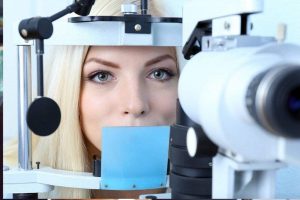An estimated 30 million Americans have diabetes, and approximately 25 to 45 percent of them will develop some form of diabetic eye damage.
According to the National Institute of Health (NIH), diabetes is the number one cause of vision loss among individuals between the ages of 20 and 74.
This means that having diabetes can increase your risk of vision loss from sight-threatening eye diseases, such as diabetic retinopathy, cataracts, and glaucoma.
While these are the most common eye diseases associated with diabetes, there are many other ocular conditions as well that can cause diabetic eye damage and lead to serious complications and vision loss.
If you suspect you have an eye condition, contact an eye doctor near you, who can diagnose and treat the condition.
SEE RELATED: What is Diabetic Retinopathy?
Factors that increase your risk of diabetic eye damage
High concentrations of sugar in the bloodstream can lead to blood vessel damage throughout the body, including the retinas of the eyes.
Retinal blood vessel damage, if left untreated, can lead to progressive ocular damage— and eventually result in vision loss.
Factors that increase your risk of diabetic eye damage include:
- Type 1 or type 2 diabetes
- Gestational diabetes
- Poorly controlled diabetes
- Ethnicity: Hispanic or African American
- High blood pressure
- High cholesterol
Type 1 and type 2 diabetes
Type 1 and type 2 diabetes are two different forms of diabetes. Both types affect the way the body regulates blood sugar, also known as glucose.
Glucose plays an important role in nourishing the body’s cells, primarily in conjunction with a hormone called insulin.
What is the difference between type 1 and type 2 diabetes?
Type 1 diabetes inhibits the production of insulin in the body and causes glucose levels in the blood to rise.
Type 1 diabetes is generally diagnosed in childhood or adolescence, though it is possible to develop this type of diabetes later in life. Symptoms of type 1 diabetes typically develop quickly and are generally noticed within a few weeks of onset.
Daily insulin injections are needed to maintain healthy blood glucose levels.
Type 2 diabetes prevents the body from responding to the insulin in the bloodstream and causes glucose levels to rise. In its later stages, it also inhibits the body from producing insulin.
Unlike type 1 diabetes, type 2 diabetes is more closely linked to age and obesity and symptoms may go unnoticed for years— some people don’t even know that they have it until complications develop.
Both types of diabetes can lead to chronic high blood sugar in the bloodstream and cause damage to the blood vessels in the body— consequently resulting in many health complications, including diabetic eye damage.
The longer you have had diabetes, the higher your risk for developing diabetic eye damage.
Gestational diabetes
Gestational diabetes, also called blurred vision, is a temporary form of type 2 diabetes that can affect pregnant women.
Gestational diabetes causes high blood sugar levels in the bloodstream and can damage the tiny blood vessels in the retina.
Having diabetes during pregnancy not only poses a health risk to the mother, but the baby as well. Moreover, gestational pregnancy increases the mother’s risk of developing chronic diabetes in the future.
Factors that may increase your risk of gestational diabetes include:
- Obesity
- Age
- Family history of type 2 diabetes
- Gaining too much weight during pregnancy
- History of gestational diabetes in previous pregnancies
- Previous birth of a baby over 9 pounds
- Ethnicity: Ancestry from Hispanic, African, Native American, South or East Asian, Pacific Island
Gestational diabetes is often asymptomatic, it is recommended that all pregnant women get a glucose screening in their third trimester of pregnancy. If gestational diabetes is detected, it is critical that the mother receives appropriate prenatal and postnatal care to prevent any health complications.
Poorly controlled diabetes
Chronic high glucose levels will not only damage the tiny blood vessels in your eyes, but will also affect the shape of your eye’s lens and cause blurry vision.
If diabetes is not controlled properly, vision loss and permanent blindness can occur.
Ethnicity
Individuals of African-American and Hispanic-American descent have a greater risk of developing diabetic eye damage. This is primarily due to the fact that they have been shown to have a greater incidence of diabetes.
- African-Americans have a 77% higher risk of diabetes.
- Hispanic-Americans have a 66% higher risk of diabetes.
In addition, studies suggest these ethnic groups contain a greater incidence of high blood pressure and heart disease, which may indirectly contribute to an increased risk of ocular disease.
High blood pressure
High blood pressure can occur with diabetes and can be harmful to the tiny blood vessels in your eyes and cause damage to your retina. When retinal damage occurs, it can cause bleeding in the retina, blurred vision, and even total vision loss.
A normal blood pressure reading is generally between 90/60 mmHg and 120/80 mmHg. High blood pressure is diagnosed when the reading is above 140/90 mmHg.
Chronic high blood pressure not only places additional stress on the blood vessels in your eyes, but on your heart, brain, kidneys, and other organs as well— increasing your risk of serious and even life-threatening conditions.
High cholesterol
High cholesterol can occur with diabetes and is typically caused by an excess of fatty cholesterol in your bloodstream.
What causes high cholesterol?
- Eating too many fatty foods
- Being overweight
- Smoking
- Drinking alcohol
- Family history
Having high cholesterol does not cause any symptoms, and can only be determined through a blood test. High cholesterol levels not only affects your heart health, but can also affect your ocular health, specifically harming your retina. High cholesterol may even increase your risk of glaucoma.
Annual eye exams can prevent vision loss
An annual diabetic eye exam can prevent 95 percent of vision loss caused by diabetes.
Early symptoms of diabetes can be subtle, and therefore diabetes may go undiagnosed for years. In order to prevent ocular damage and vision loss from uncontrolled diabetes, eye doctors recommend annual eye exams for anyone who may be at risk for diabetes.
If you notice any of the following changes to your vision, contact your eye doctor as soon as possible:
- Blurred vision
- Poor night vision
- Floaters
- Light sensitivity (photophobia)
During an annual eye examination, your eye doctor can detect signs of diabetic eye damage, even before diabetes symptoms are noticed.
LEARN MORE: Guide to Eye Conditions
Schedule an appointment with an eye doctor for a comprehensive eye exam, and to discuss any questions you may have about treating your eye condition.
With a healthy lifestyle and proper care, you can reduce your risk of diabetic eye damage— protecting both your eye health and vision.


